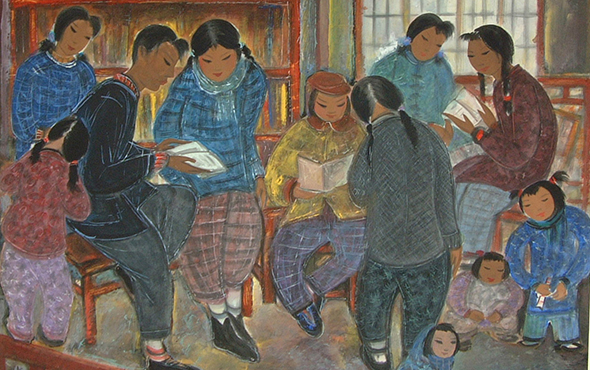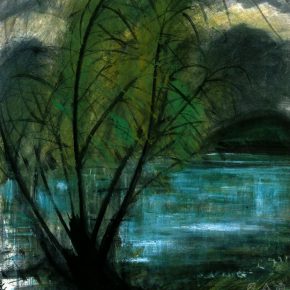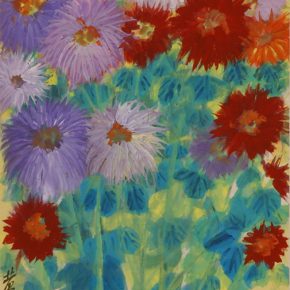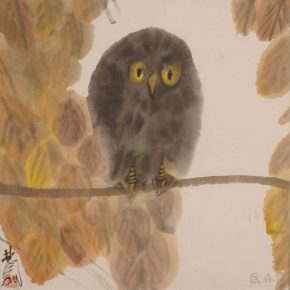
Jointly hosted by the China Artists Association, the Shanghai Artists Association, the Shanghai Academy of Chinese Painting, China Art Museum Shanghai, Beijing Fine Art Academy, and organized by the Art Museum of Beijing Fine Art Academy, “Lonely and Quiet Shadows of Ducks – Lin Fengmian’s Art Exhibition” opened at the Art Museum of Beijing Fine Art Academy on January 20, 2017. The exhibition brings together 36 masterpieces by Lin Fengmian from the 1940s to the 1970s in the 20th century, and the works cover Lin Fengmian’s representative works of still life, flowers, ladies, birds and landscape. Most of the exhibits are from the collections of the Shanghai Artists Association, the Shanghai Artists Association, the Shanghai Academy of Chinese Painting and China Art Museum Shanghai, and it also presents two works collected by Beijing Fine Art Academy.
Lin Fengmian is an important painter in the history of Chinese painting in the 20th century. The important significance does not only lie in that he was a representative of the fusion of Chinese and Western schools, with his dramatic discourse and demands, as well as the creative achievements that enrich the history of painting in the 20th century, but also because of his unique life experiences and the meaningful way of dealing intensively and clearly with the unique cultural context of the history of painting in the 20th century.
As an artist, he combined Western modernism with the essence of Chinese folk art, with unique achievements; as an artist, he had cultivated a large number of famous artists, such as Li Keran, Zao Wou-ki, Chu Tech-chun, Wu Guanzhong, Xi Dejin, Wang Shikuo, Luo Gongliu and so on, and his contributions are well-known. He not only has an important page in the history of Chinese art in the 20th century, but also a wide range of international influences.
A Work of the Collections Reminds Us of a Story between Lin Fengmian and Qi Baishi ??It first presents the “Rooster Figure” (collected by Beijing Fine Art Academy) byLin Fengmian who gifted it to Qi Baishi, and it is a selected art work of the collections of Qi Baishi. It uses light ink lines to unrestrainedly and smoothly draw three white feather roosters, and the combs are ruby-like flashes. The simple and fresh brush reveals that it imitates the porcelain folk paintings.
In the winter of 1925, Lin Fengmian returned to China after having studied aboard,? the following February he was appointed as the Principal and professor of National Beiping Art School. He became the youngest principal of the universities and colleges of art in China in the 20th century. In 1927, he employed Qi Baishi to teach in the school, Qi Baishi recorded this event in detail in the “Autobiography of Qi Bqishi” (Qi Baishi talked, and Zhang Cixi recorded). This happened 90 years ago, and this exhibition is held in the Art Museum of Beijing Fine Art Academy now, which no doubt gives the audience special memories and images.
The Road of Integration, Masterpieces during the Mid-Life of Lin Fengmian?In the 20th Century Chinese art circles ideas and practice appeared in a variety of “fusion” such as the art of Lingnan School, Xu Beihong, Lin Fengmian and Liu Haisu. They realized that Chinese and Western fusion was the best way and inevitable trend for Chinese art? as it integrated into the world, to varying degrees. From 1938 to 1977, Lin Fengmian resigned from the post of principal of the National Hangzhou Art School, and started a lonely art exploration. He was inclined to combine the Western style of evolution from Romanticism to? Cubism with the early Chinese traditions of the Han and Tang dynasties and folk art, to practice the ideal of “reconciling Chinese and Western art”. Most of the exhibited works were created in this period, and the themes include: landscape, ladies, birds, flowers and still life.
During this period, Lin Fengmian mainly considered the form, and the fusion of Chinese and Western painting technology, he carried out a wide range of experiments and perfectly expressed them, and he absorbed the expressive forms of Western modernism, tending to use highly nutritious elements such as bricks from the Han Dynasty, lacquer painting and shadow play in Chinese folk art, with a large number of artistic practices and his own innovative, unique works to answer the complex and changing art issues of the 20th century.
Text by Zheng Zhiwei, translated by Chen Peihua and edited by Sue/CAFA ART INFO
Photo by the organizer
About the ExhibitionDuration: January 20 - March 5, 2017
Venue: the 1st and 2nd floor of the Art Museum of Beijing Fine Art Academy
Hosts: China Artists Association, the Shanghai Artists Association, the Shanghai Academy of Chinese Painting, China Art Museum Shanghai, Beijing Fine Art Academy
Organizer: Art Museum of Beijing Fine Art Academy
About the ArtistLin Fengmian (1900-1991), formerly known as Lin Fengming, was born in Mei County, Guangdong Province. He participated in the?Diligent Work-Frugal Study Movement and moved to France to work and study Western painting in 1919. First of all, he studied Western painting in école nationale supérieure d'art de?Dijon, and then transferred to école nationale supérieure des Beaux-arts de Paris, following this he traveled to Germany. In 1925 he returned to China, where he became the principal of the National Beiping Art School and a professor. In 1927, invited by Cai Yuanpei, Lin went to Hangzhou where he founded the National Academy of Art (now called the?China Academy of Art), becoming its first principal. He was one of the pioneers of the new art movement in China, one of the founders of modern art education. He was a member of the China Artists Association and Vice Chairman of the Shanghai branch of China Artists Association.

















































